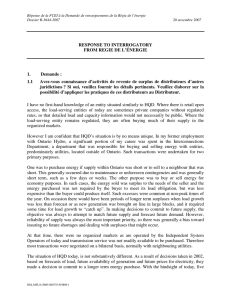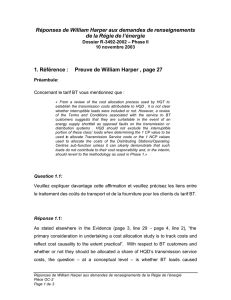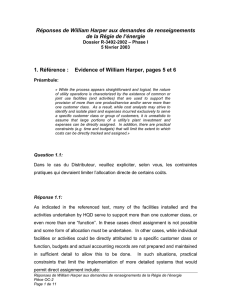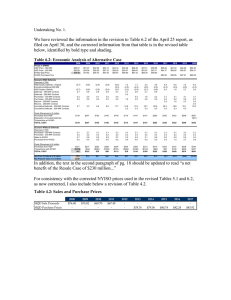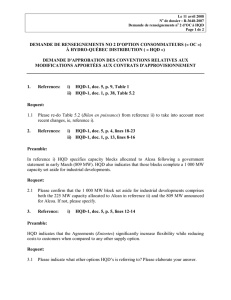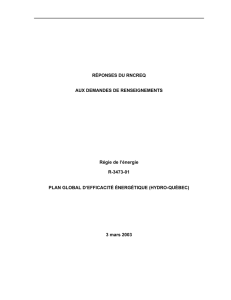Demande de renseignements numéro 1 de la Régie de l’énergie Préambule
advertisement
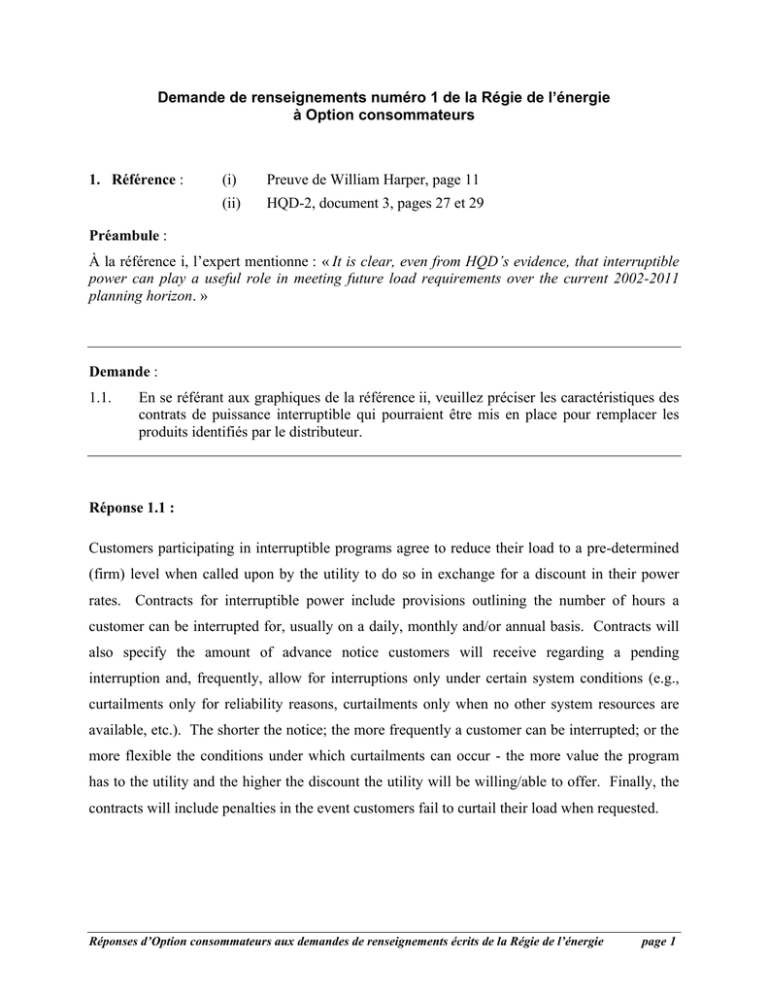
Demande de renseignements numéro 1 de la Régie de l’énergie à Option consommateurs 1. Référence : (i) Preuve de William Harper, page 11 (ii) HQD-2, document 3, pages 27 et 29 Préambule : À la référence i, l’expert mentionne : « It is clear, even from HQD’s evidence, that interruptible power can play a useful role in meeting future load requirements over the current 2002-2011 planning horizon. » Demande : 1.1. En se référant aux graphiques de la référence ii, veuillez préciser les caractéristiques des contrats de puissance interruptible qui pourraient être mis en place pour remplacer les produits identifiés par le distributeur. Réponse 1.1 : Customers participating in interruptible programs agree to reduce their load to a pre-determined (firm) level when called upon by the utility to do so in exchange for a discount in their power rates. Contracts for interruptible power include provisions outlining the number of hours a customer can be interrupted for, usually on a daily, monthly and/or annual basis. Contracts will also specify the amount of advance notice customers will receive regarding a pending interruption and, frequently, allow for interruptions only under certain system conditions (e.g., curtailments only for reliability reasons, curtailments only when no other system resources are available, etc.). The shorter the notice; the more frequently a customer can be interrupted; or the more flexible the conditions under which curtailments can occur - the more value the program has to the utility and the higher the discount the utility will be willing/able to offer. Finally, the contracts will include penalties in the event customers fail to curtail their load when requested. Réponses d’Option consommateurs aux demandes de renseignements écrits de la Régie de l’énergie page 1 Contract terms will vary. However, annual hours of curtailment are likely to be in the range of 100 to 750 hours per year, with longer curtailment periods requiring more notice. As a result, interruptible power programs are used as an alternative to reserve or peaking capacity that would only be expected to operate for a short period of the year. In terms of the graphs portrayed on page 27-29 of HQD-2, Document 3, interruptible power would be an alternative option to meeting HQD’s requirements for “service modulable”, and then only that portion of the “service modulable” requirement that is required for limited number of hours. It would not be a reasonable substitute for all of the “service modulable” capacity shown in Graph 3.1 as being required in 2007, since under normal condition some that capacity will be expected to operate for up to 6000 hours a year. Réponses d’Option consommateurs aux demandes de renseignements écrits de la Régie de l’énergie page 2 2. Référence : Preuve de William Harper, page 11 Préambule : « If appropriate programs were introduced by HQD to ensure that a portion of these households participated in the dual-energy program (equivalent to the proportion of total households currently participating in the program) then peak demand in 2011 could be reduced by roughly 100 MW. » Demande : 2.1. Veuillez indiquer les hypothèses qui conduisent à une réduction de 100 MW. Réponse 2.1: HQD has indicated (HQD-2, Document 1, page 20) that the load reduction attributable to the residential dual-energy program is 880 MW in 2002/2003 and that for purposes of the supply plan this value remains unchanged throughout the planning period. HQD has also indicated that it expects the number of residential heating customers to increase by 1.2% per annum. If programs were introduced that ensured the participation in dual-energy programs simply kept pace with the growth in residential heating customers then the increase in load by 2011 would be: 880 MW x [(1+1.2%)8 – 1.0] or roughly 90 MW Allowing for losses increases this value to roughly 100 MW in terms of generation required. Réponses d’Option consommateurs aux demandes de renseignements écrits de la Régie de l’énergie page 3 3. Référence : Preuve de William Harper, page 14 Préambule : « The application of market considerations reduces the potential import limit in the peak period by roughly 10 TWh (i.e., from 15.6 TWh to 5 TWh). Such considerations may have been appropriate prior to market restructuring/open access when utilities essentially constructed all of the generation capacity and exported power surplus to their needs. However, contrary to HQD’s claims, it is not appropriate in today’s or tomorrow’s emerging market place. To the extent that there are no transmission limitations in neighbouring systems, extra- provincial utilities or other providers of generation are free to enter into longer-term firm supply contracts with HQD that would utilize some or all of the available 10 TWh of import capacity and the security of the power would be the same as for that contracted for from sources inside Québec. » (nous soulignons) Demandes : 3.1. Veuillez préciser la durée (nombre d’années) des « longer-term firm supply contracts ». 3.2. Veuillez indiquer si un tel contrat diminuerait la capacité réelle d’importation de la même quantité que celle stipulée au contrat. Veuillez expliquer votre réponse. Réponse 3.1: The reference to “longer-term” was not meant to imply a specific contract duration. In deregulated electricity markets, buyers and sellers are able to enter into contracts of varying durations (e.g., 5 years, 10 years, or perhaps more). My comments were meant to raise the issue that by excluding the participation of external suppliers (via existing transmission facilities), HQD will never know if there are external suppliers interested in entering into long-term supply arrangements. Réponses d’Option consommateurs aux demandes de renseignements écrits de la Régie de l’énergie page 4 Réponse 3.2: Contracts for firm imports utilizing existing facilities would decrease the import capability available for short-term purchases. However, as my Phase II Evidence (Page 14, lines 6-7) indicates, HQD has reduced the potential for imports in the peak period by 10 TWh (i.e., from 15.6 TWh to 5 TWh) based on market considerations, including concerns about the availability of generation capacity on the “other side” of the interties. Therefore, to the extent that any longer longer-term contracts demonstrate that additional generation capacity is available (for purchase), such contracts will not have any impact on the level of transmission capacity HQD is assuming will be available for imports. Furthermore, as noted in my Evidence (Page 14, lines 18-23), HQD could limit participation so as to ensure that the capacity it was relying on as part of overall supply plan was available. Réponses d’Option consommateurs aux demandes de renseignements écrits de la Régie de l’énergie page 5 4. Référence : Preuve de William Harper, page 16 Préambule : « The associated probability of load outstripping supply is in the order of 15 %. » Demande : 4.1. Selon l’expert, est-il possible que les achats de court terme soient plus élevés que 8,9 TWh? Veuillez expliquer votre réponse. 4.2. Quel serait alors l’effet sur la valeur de 15 % ? Réponse 4.1: HQD, in HQD-4, Document 6, page 31, indicated that the maximum supply available from shortterm purchases in 2007 would be 8.9 TWh. However, HQD has also indicated, both in the same reference and in HQD-6, Document 7, page 31, Question 17.3, that it is uncertain as to exactly how much would be supplied from interruptible loads, interconnections and other sources of short-term supply. As result, it appears that the 8.9 TWh is an estimate and that the actual shortterm purchases available could prove to be higher, or lower. Réponse 4.2: If more power was available through short-term purchases, the probability of load outstripping supply would decrease. For example, if amount available from short-term purchases increased to 10 TWh, the probability would be in the order of 12%. Réponses d’Option consommateurs aux demandes de renseignements écrits de la Régie de l’énergie page 6 This result is based on the following sources and assumptions: § The average demand and standard deviations set out in HQD-6, Document 1, page 13, § Incremental supplies as per the Evidence (page 16), assuming short-term supply of 10 TWh as opposed to 8.9 TWh, § Heritage Pool supply of 178.9 TWh (HQD-2, Document 3, page 2), and § Average of results for 2007 and 2009 Réponses d’Option consommateurs aux demandes de renseignements écrits de la Régie de l’énergie page 7 5. Référence : Preuve de William Harper, page 17 Préambule : « Precisely how much HQD can count on from short term purchases will not be fully understood until the current RFP process has been completed; » Demande : 5.1. Veuillez expliquer comment le processus d’appel d’offres (RFP process) peut avoir un impact sur les possibilités d’achats de court terme. Réponse 5.1: In the quoted statement the Evidence was referring to the various calls for tenders HQD has indicated (HQD-2, Document 3, pages 34-35 (Needs for 2002-2005) and HQD-6, Document 1, page 33, Question 18.1) it would be initiating to acquire short-term power and energy supplies. Once potential suppliers have responded to these tendering processes, HQD will have a better understanding of how much power/energy it can rely on from short-term purchases. Réponses d’Option consommateurs aux demandes de renseignements écrits de la Régie de l’énergie page 8 6. Référence : Preuve de William Harper, page 18, lignes 22 à 28 Préambule : L’intervenant mentionne que la disponibilité d’une capacité de stockage permettrait au distributeur de réduire ses besoins en nouveaux équipements. Demande : 6.1. Veuillez expliciter davantage comment cela pourrait se concrétiser. Réponse 6.1: The new supply requirements identified by HQD in its Application are based on the assumption that HQD will be able to optimize the dispatch of the supplies available from the Heritage Pool so as to minimize new supply requirements. However, in Section 4.5 of my Phase II Evidence, some concerns are raised as to whether HQD will be able to fully optimize the dispatch of Heritage Pool (see page 12, lines 19-28). This is because, at any point in time, the loads for the balance of the year are not known with perfect foresight and, as a result, HQD may not make the optimum decision with respect to the dispatch of available Heritage Pool supplies on a day-to-day basis. This, in turn, could lead to an increase in total supply requirements. The availability of storage would provide HQD with a tool to manage the Heritage Supply in those situations where actual loads turn out different from those anticipated when the initial dispatch and address variations (positive or negative). In addition, HQD has indicated that the interconnection capability in the off-peak period is 15 TWh after consideration of market constraints but that it can only make use of 5 TWh for purposes of meeting demand (see HQD-4, Document 1, page 30 and HQD-6, Document 1, page 28, question 13.1). This suggests there may be an opportunity for HQD to use a combination of storage and additional off-peak purchases to meet incremental demand – where during the offpeak period demand would be met by purchases and water resources “stored” to be used to meet demand in the peak period. Réponses d’Option consommateurs aux demandes de renseignements écrits de la Régie de l’énergie page 9
